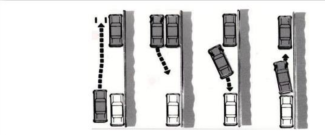Stopping and Parking
Stopping
Stop: When stopping, drivers should completely cease all forward motion for a minimum of three seconds. This gives the driver time to look left, look right, look center, look left again, and proceed with caution.
Where to stop:
RIGL 31-20-9 Obedience to stop signs. – Every driver of a vehicle approaching a stop sign shall stop before entering the crosswalk on the near side of the intersection. In the event there is no crosswalk, the driver shall stop at a clearly marked stop line. If no stop line exists, then stop at the point nearest the intersecting highway where the driver has a view of approaching traffic on the intersecting highway before entering the intersection, except when directed to proceed by a police officer or traffic control signal.
Four-Way Stops
Follow these procedures when at an intersection with a four-way stop:
- Once stopped, you must yield to all other vehicles that were stopped prior to your arrival at the stop sign.
- Once having stopped, all other vehicles arriving at the intersection after you must yield the right of way to you.
- If two vehicles arrive at the intersection at the same time, you must yield the right of way to the vehicle on your right.
- As always, being courteous and respectful will help prevent dangerous situations and make the roadways safer for all drivers.
To leave a traffic lane to enter a parking space/parallel parking
- Move into the traffic lane nearest the parking space.
- Use a turn signal to indicate your intentions.
- Enter the parking space using the four (4) steps shown in the diagram below.
- Stop the engine, lock the ignition switch, remove the key, and set the parking brake.

To enter a traffic lane from a parked position:
- After starting the engine and releasing the parking brake, maneuver the vehicle to a position from which reentry into the traffic lane can be made in one motion.
- Look to the rear. Check the rear view and side view mirrors and look over your left shoulder to cover the blind spots.
- Signal first, then drive from the parking spot carefully.
- Enter the driving lane that is closest to the parking space.
How to park on hills:

Where you may not park or stop:
- On the travel portion of the highway.
- Beside a vehicle stopped or parked at the side of a street (Double Parking).
- On a sidewalk.
- Within an intersection.
- Beside any roadwork so that you block traffic.
- On a bridge or in a tunnel.
- On any railroad tracks.
- Any place where official signs prohibit stopping.
- In front of any driveway.
- Within 8 feet of a fire hydrant.
- Within 20 feet of a crosswalk at an intersection.
- Within 30 feet of a flashing red or yellow light, a stop sign, or a traffic light.
- Within 20 feet of the driveway of a fire station or across the street within 75 feet of the driveway, where there are signs.
- Any place where a sign says, ‘No Parking’.
- Within 50 feet of the nearest rail or a railroad crossing unless you stop for just a short time to load or unload passengers or packages.
- At any curb cut or ramp for handicapped persons.
Unless a law prohibits parking, a vehicle parked on a two-lane road must have the right wheels a maximum of twelve (12) inches from the right side of the road or curb. On a one-way road, a parked vehicle may have either wheel a maximum of twelve (12) inches from the side of the road and headed in the same way the traffic goes.